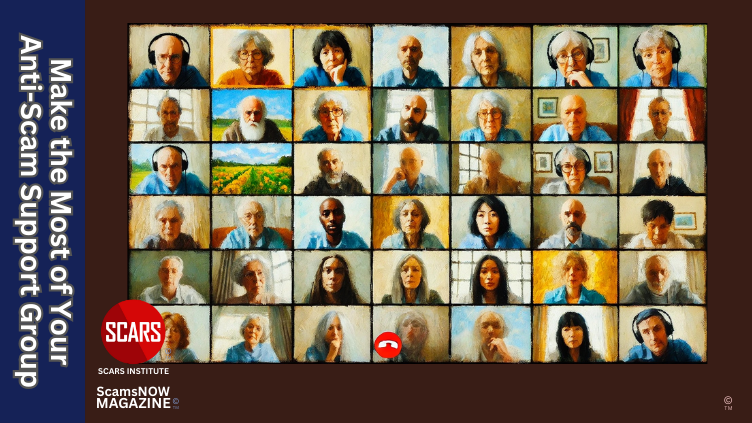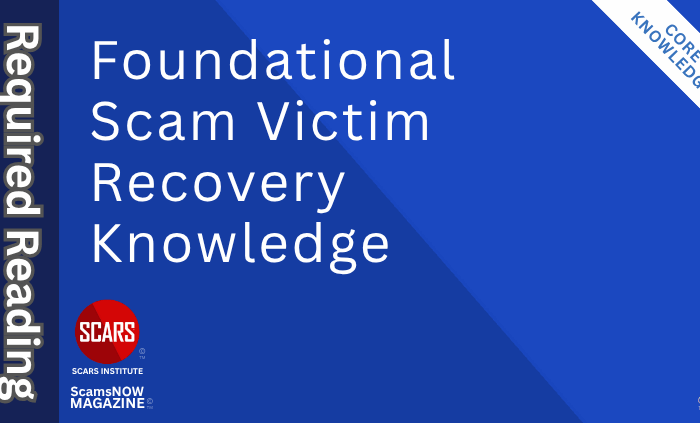
How to Make the Most of Your Anti-Scam Support Groups
Turning a Chatty Anti-Scam Victims’/Survivors’ Support Groups into a Real Support Space
Primary Category: Advocacy
Authors:
• Vianey Gonzalez B.Sc(Psych) – Licensed Psychologist, Specialty in Crime Victim Trauma Therapy, Neuropsychologist, Certified Deception Professional, Psychology Advisory Panel & Director of the Society of Citizens Against Relationship Scams Inc.
• Debby Montgomery Johnson, President and CEO of BenfoComplete.com, Online Scam/Fraud Survivors Advocate, Author, Keynote Speaker, Trainer, Podcast Host, USAF Veteran, Chair and Director of the Society of Citizens Against Relationship Scams Inc.
Author Biographies Below
About This Article
A practical path transforms chat-focused anti-scam support groups into trauma-aware support spaces by prioritizing consent, confidentiality, truthful communication, paced sharing, nonjudgmental curiosity, and compassionate action. Clear member roles such as welcomer, question-asker, timekeeper, reflector, and resource curator create reliable structure across social media threads, video meetings, and in-person circles. Techniques that draw survivors out include open questions, affirmations, reflections, summaries, layered inquiry, feeling language, and brief skills practice. Storytelling serves first for validation and then gives way to present-focused healing through small, specific next steps. False encouragement and toxic positivity are reduced by testing messages for accuracy, compassion, and immediate usefulness. Broad participation grows through round-robins with passes, pair shares, chat prompts, spotlight rotations, and respectful timekeeping, while tough dynamics are contained with calm redirecting and grounding. Short recovery practices, privacy safeguards, and gentle indicators of group health sustain progress, and guest experts, including SCARS Institute directors, strengthen education and engagement so honesty, compassion, and realistic action move recovery forward.
Note: This article is intended for informational purposes and does not replace professional medical advice. If you are experiencing distress, please consult a qualified mental health professional.

Turning a Chatty Anti-Scam Victims’/Survivors’ Support Groups into a Real Support Space
Author’s Note
You deserve support groups that honor your pain, respect your pace, and help you heal. You do not need to perform strength or hide your distress. You need a place where you can speak honestly, feel heard, receive truthful guidance, and take small steps forward. This article speaks to you directly and offers a practical path to transform any group that mostly chats about daily life into a trauma-aware support group that genuinely helps recovery. You will find clear principles, sample agendas, facilitation scripts, and techniques that you can use today in social media groups, on video calls, or in person.
This article is intended for group operators, advocates, and those participating in support groups.
Why Many Groups Drift into Small Talk
You join a group because you want connection and relief, yet many groups slide into friendly chatter. This happens because small talk feels safer than grief, shame, and fear. It also happens because people copy each other’s tone. If the loudest voices keep it light, most people follow. You also see members say they are fine because they worry that telling the truth will burden others or spark judgment. None of this makes anyone weak. It simply shows how the nervous system protects you from pain. You can change this pattern by setting a different norm, inviting real emotions, and modeling honest speech.
The Core Shift: From Community to Support
Community feels good. Support moves you forward. You need both, yet you must be deliberate about the support part. You keep the warmth and kindness. You add structure, intention, and truthful dialogue about trauma and recovery. You make it normal to ask about feelings, nervous system states, and coping. You make it normal to discuss small next steps. You make it normal to say what is hard without pressure to wrap it in a bow.
Foundational Principles That Make Groups Safer and Stronger
You create safety with intention on purpose. You do not assume it. Use these SCARS Institute principles and repeat them often.
- Consent and choice.
You always offer invitations, not commands. You say, “Share only what feels safe for you today.” You respect silence. - Confidentiality.
You promise not to share other people’s stories outside the group. You remind everyone of this in writing and out loud. - Honesty before positivity.
You value truth over comfort. You say, “We do not skip pain to get to hope. We tell the truth and then we find hope that fits reality.” - Pacing and titration.
You encourage short, focused shares. You keep people inside their window of tolerance by slowing down, taking breaths, and pausing when emotions spike. - Nonjudgmental curiosity.
You listen to understand, not to fix. You ask open questions and reflect feelings back. - Action with compassion.
You end with one small, specific next step that the member chooses. You respect limits and never pressure.
Member Roles You Can Adopt Right Now
You do not need titles to lead. You can try any of these roles for a week and see what helps.
- Welcomer.
You greet new members by name and post a simple orientation: how the group works, how to ask for help, and what a typical share looks like. - Question-Asker.
You post a daily or weekly check-in question that goes beyond small talk, such as, “What feeling word describes your morning, and what helped you cope?” - Timekeeper.
You help keep shares to a respectful length so more people can speak. You use kind language, such as, “Let’s land this share in the next minute so others can be heard too.” - Reflector.
You mirror back what you heard. You say, “I heard sadness and fear about finances, and I heard courage in how you set a boundary.” - Resource Curator.
You gather articles, worksheets, and exercises relevant to common struggles, such as sleep, boundaries, intrusive thoughts, and shame.
Meeting Architecture That Works Online and In Person
You transform a group by giving it a gentle structure that repeats. You can adapt these templates for social media threads, Zoom calls, or in-person circles.
Social Media Thread Format:
-
- Opening prompt.
You post: “Check-in: name, one feeling word, one sentence about your current challenge, and one small step you will take before tomorrow.” - Story window.
You invite brief stories that validate experience. You cap each story at five to eight sentences. You nudge with, “State the facts, name the feeling, and name one thing you need.” - Reflection round.
Members respond with one reflection and one question that invites depth, such as, “What felt hardest in that moment, and what helped even a little?” - Resource or practice.
You add a short skill post, such as a two-minute breathing pattern, a grounding exercise, or a boundary script. - Closing acknowledgment.
You close the thread by naming themes and next steps. You say, “We honored grief and fear today. Your next steps include sleep hygiene, journaling, and one boundary with a contact.”
- Opening prompt.
Zoom Call Format, 60 to 120 Minutes
-
- Arrival and grounding, three minutes.
You invite two slow breaths and a sip of water. You say, “Notice your feet on the floor and soften your shoulders.” - Frame and agreements, two minutes.
You restate consent, confidentiality, and time limits. - Check-in round, ten to fifteen minutes.
Each person shares a feeling word and a sentence about their current state. - Focused shares, 5-10 minutes each.
Two or three people share for 5 to 10 minutes each. After each share, two reflections and one open question invite depth, not advice. - Micro-teaching, five to ten minutes.
You introduce one skill, such as the RAIN practice, a self-compassion break, or a boundary script. - Action steps and support asks, ten minutes.
Each participant states one specific next step and one way the group can support them. - Closing ritual, 5-10 minutes.
You end with a breath, a hand on heart, or a simple phrase, “You did something brave by showing up.”
- Arrival and grounding, three minutes.
In-Person Circle Format
You use the same sequence as Zoom and add physical grounding, such as a chair stretch or a short walk during a midway break. You provide printed feeling word lists and a simple worksheet for the story-to-healing pivot.
Techniques That Draw People Out Without Pressure
You help people speak when you create safety, ask focused questions, and show that you can handle the truth.
Use ‘OARS’ Micro-Skills
-
- Open questions.
You ask, “What felt most overwhelming this week?” and “What do you wish someone had said to you that day?” - Affirmations.
You name real strengths, “It was not my fault,” “I am a survivor,” “I am not alone,” “I am worthy – AXIOS.” - Reflections.
You mirror content and emotion, “You felt ashamed when the bank called, and you also felt angry at the scammer.” - Summaries.
You tie threads together, “You lost savings, you felt alone, and you called a hotline. You want steadier sleep and a plan for debt.”
- Open questions.
Use Layered Questions
You start wide, then go deep with consent.
-
- Start with safety.
“Would you like to share about your week or simply listen today?” - Invite specifics.
“When did you notice the anxiety rise, and where did you feel it in your body?” - Explore meaning.
“What story did your mind tell you about that moment, and how true does that story feel now?” - Support choice.
“What would help you feel ten percent safer this evening?”
- Start with safety.
Use Feeling Language
You share a simple list of emotions and ask for one word. You normalize tears and pauses. You say, “Taking a breath is part of speaking.”
From Story to Healing: Validating, Then Letting Go
Your story matters. You deserve validation. You also deserve freedom from telling the same story forever. You can use a clear progression that honors both needs.
-
- First phase: validation.
You tell the story once or twice in a contained way. You state facts without self-blame. The group reflects feelings, names the harm accurately, and affirms that you did not cause the crime. - Second phase: learning.
You ask, “What did you learn about your nervous system, your boundaries, or your risk signals?” You extract lessons without shaming yourself. - Third phase: present focus.
You shift toward current needs, such as sleep routines, finances, family conversations, and safe dating choices. - Fourth phase: action.
You pick one small next step and report back next time.
- First phase: validation.
A simple story structure
Fact. Feeling. Forward step.
You share the key event in three to five sentences. You name two feelings. You name one next step. You let the group reflect and support you. You let the story live in your journal rather than on repeat in your mouth.
Guarding Against False Encouragement and Toxic Positivity
You need hope that tells the truth. You do not need pretty lies. You protect yourself and others by testing messages before you share them.
Common harmful phrases and truthful alternatives
-
- Harmful: “Everything happens for a reason.”
Truthful: “What happened was wrong, and you did not cause it. You can find purpose in how you heal.” - Harmful: “Just stay positive.”
Truthful: “Your feelings make sense. Let us sit with them for a moment and then find one next step that helps.” - Harmful: “You should be over this by now.”
Truthful: “Time alone does not heal trauma. Practice, support, and honest work help you heal.”
- Harmful: “Everything happens for a reason.”
A Simple Truth Test
You ask three questions before posting a message. Is it accurate? Is it compassionate? Is it useful now? If any answer is no, you rewrite or you do not post.
Keeping Everyone Participating Without Forcing Anyone
You invite wide participation with a gentle structure.
-
- Round-robins with passes.
You give each person a turn and allow passes with no pressure. You revisit anyone who passed later if they wish. - Pair shares.
You break a larger group into pairs or trios for five minutes. People often speak more freely in smaller settings. - Chat prompts.
On Zoom, you invite one-line responses in chat to a focused question. You read several out loud and reflect themes. - Spotlight rotation.
You rotate two deeper shares each meeting so everyone eventually has time in the center. - No cross-talk rule during a share.
You let the speaker finish. You post reflections and questions after.
- Round-robins with passes.
Handling Tough Dynamics With Care
You will meet patterns that derail safety. You can respond with clarity and kindness.
Group Member Dynamics
-
- The monopolizer.
You set time limits ahead of time and use a visible timer. You say, “Let us pause here so others can speak. We can return if time allows.” - The fixer.
You redirect advice to curiosity. You say, “Before solutions, let us make sure we understand the feelings. What felt hardest for you?” - The minimizer.
You protect the speaker from comparison. You say, “Pain is not a contest. Every experience matters here.” - The trigger spiral.
You slow down and invite grounding. You say, “Place your feet on the floor and take two slow breaths. Would you like a pause or a shorter share today?” - Crisis moments.
You keep a simple plan. You share hotline numbers, you suggest contacting local supports, and you do not try to be a therapist. You say, “You deserve immediate help. Here is the crisis line. Would you like me to stay while you make the call?”
- The monopolizer.
Practical Skills You Can Teach in Ten Minutes
You strengthen a group by adding bite-sized learning. You can rotate who teaches.
-
- Two-minute breath.
You inhale for four, exhale for six, repeat for two minutes. - Grounding through the senses.
You name five things you see, four you feel, three you hear, two you smell, one you taste. - Thought labeling.
You notice a harsh thought and say, “My mind is telling me a scary story.” You choose a kinder, truer sentence. - Boundary scripts.
You practice, “I am not discussing money today. I appreciate your concern. I will update you when I am ready.” - Sleep anchors.
You choose a wind-down time, reduce light, and reserve the bed for sleep only. You avoid screens for thirty minutes before bed.
- Two-minute breath.
Integrating Education and Guest Speakers
You enrich the group by bringing in experts and trusted educators. You can invite guest speakers from reputable organizations, including SCARS Institute directors, to present compact, practical sessions that align with your members’ needs.
The SCARS Institute provides FREE Guest Speakers for anti-scam groups at no cost. To inquire about this, please email us at speakers@AgainstScams.org
A simple guest plan
-
- Identify themes.
You poll members about topics, such as coping with shame, rebuilding trust, reporting and recovery logistics, or speaking with family. - Choose the format.
You host a 20-minute teaching segment followed by a 20-minute moderated Q and A. You keep the focus on practical steps. - Prepare together.
You send your speaker a brief about your group’s size, typical struggles, and boundaries. You ask for handouts or links you can share after the session. - Set expectations.
You remind members that this is education, not therapy or legal advice. You encourage questions that help many people, not case-specific consultations. - Follow up.
You post a summary of key points and one small action each member can take. You invite feedback on what helped and what you want next.
- Identify themes.
Recovery Practices That Turn Sharing Into Healing
You convert insight into change with small, repeatable actions.
- The three-by-three practice.
You name three feelings, three supports you did today, and three tiny steps for tomorrow. - The five-minute journal.
You write one paragraph about your current challenge, one paragraph about what you can influence, and one sentence about the next step. - The accountability buddy.
You pair with a member and exchange a midweek message. You say, “I did my step” or “I struggled and will try again.” - The boundary rehearsal.
You role-play a hard conversation in the group and practice a calm, clear script. - The media diet.
You choose one day a week without scam-related news or accounts. You give your nervous system a rest.
Digital Hygiene and Privacy
You protect yourself as you share. You use first names only. You avoid posting identifiable details about cases or finances. You lock down privacy settings, remove scammer images from your devices, and avoid direct messages with strangers. You ask moderators to remove harmful content or suspected scammers quickly. You report harassment and keep screenshots when needed.
Measuring Group Health Without Turning It Into a Test
You track gentle signals that your group is working.
-
- Participation.
More people speak and post over time, and pass rates decrease. When groups stop participating, shut the group down. - Depth.
Members use feeling words and ask for specific support. - Follow-through.
People report back on small steps and celebrate realistic wins. - Safety.
Members say they feel calmer after meetings and know what to do next. - Retention.
People keep showing up, and newcomers return.
- Participation.
Two Sample Weekly Calendars You Can Adopt
Option one: education plus connection
-
- Monday: check-in prompt thread with feeling word and small step.
- Wednesday: short skill post and practice, such as grounding or a boundary script.
- Friday: Zoom call with two focused shares and a micro-teaching.
- Monthly: guest speaker session with Q and A, such as a SCARS Institute director on trauma recovery or reporting.
Option two: story pivot to action
-
- Tuesday: story window thread with the three-part structure, fact, feeling, forward step.
- Thursday: resource round-up and pair accountability sign-ups.
- Saturday: open social hour that remains intentional, one icebreaker question plus one feelings question.
Sample Scripts You Can Copy and Use
Opening
“Welcome. Share what feels safe. We honor confidentiality. We do not fix each other. We tell the truth and take one small step forward.”
Inviting depth
“You said you are fine. Would you like to name one feeling under the surface, even if it is small.”
Reflecting
“I hear grief and fatigue. I also hear strength in how you asked for help.”
Redirecting advice
“Let us pause solutions. What is the feeling underneath, and what support would feel helpful right now.”
Timekeeping
“Let us take one more minute to land this share so we can hear from others.”
Closing
“You showed courage by being here. Please drink water, breathe slowly, and message a buddy if you feel stirred up.”
How You Move From Today to a True Support Culture
You do not wait for perfect leadership. You begin by modeling the behavior you want. You write the check-in prompt. You ask an honest question. You share your feeling word and one forward step. You gently protect time and space. You offer truth instead of false comfort. You invite experts to teach practical skills. You keep the door open for people who only want community, and you keep naming that this group exists to help members heal. Over time, the tone shifts. People learn that honesty is safe here. People learn that action is encouraged and never forced. People learn that their story does not define their future, and that they can place their story on the shelf while they build a life.
Bringing It All Together
You deserve a group that changes your day and, little by little, your life. You can transform a chatty space into a support community by creating clear agreements, modeling honest speech, inviting feelings, and pacing stories so they lead to healing. You can balance warmth with structure. You can fight the lure of false encouragement by choosing truth that is kind and useful. You can keep participation wide and safe by using round-robins, pair shares, timekeeping, and gentle redirects. You can anchor each meeting in a small skill that people can use tonight. You can invite guest speakers, including SCARS Institute directors, who respect trauma and offer concise, practical guidance. You can protect privacy, track gentle progress, and celebrate realistic wins. Most of all, you can lead with compassion and steadiness while honoring your limits.
You do not need to wait for permission. You can start with one prompt, one honest question, and one brave share. You can ask for help from peers and trusted educators. You can shape a culture where people tell the truth, feel less alone, and take steps that restore safety, dignity, and hope. That is support. That is recovery in motion. That is the group you deserve.

Glossary
- Accountability Buddy — A peer partner who checks in on agreed small steps and offers steady encouragement. The buddy system increases follow-through and reduces isolation by creating a predictable touchpoint during the week.
- Action Steps — Small, specific next moves chosen by the member after sharing. Clear actions shift attention from rumination to progress and allow the group to celebrate realistic wins.
- Affirmations — Honest statements that name strengths or efforts without denying pain. Accurate affirmations interrupt shame and support motivation for change.
- Boundaries — Clear limits on topics, time, or access that protect safety and focus. Healthy boundaries prevent overwhelm and reduce pressure to disclose more than feels safe.
- Boundary Scripts — Short phrases practiced in advance to enforce limits with calm clarity. Rehearsed language helps a member hold the line when emotions rise.
- Chat Prompts — Focused one-line questions posted in meeting chat to increase participation. Simple prompts invite quieter members to engage without speaking aloud.
- Check-In Round — A brief first pass where each person names a feeling and a current challenge. Short check-ins set an honest tone and surface who may need focused time.
- Closing Ritual — A consistent ending practice such as shared breaths or a short phrase of acknowledgment. Predictable closings signal safety and help the nervous system settle.
- Confidentiality — A group agreement that members will not share others’ stories outside the space. Clear reminders protect privacy and build trust over time.
- Consent and Choice — An approach that invites sharing rather than demanding it. Consent allows members to pass or pause, which reduces retraumatization and increases safety.
- Crisis Plan — A simple, prepared response for moments of acute distress, including hotline numbers and local resources. A plan keeps helpers within role and connects the member to immediate support.
- Digital Hygiene — Practical steps that reduce online risk, such as tightening privacy settings and avoiding direct messages with strangers. Clean digital practices protect identity and lower exposure to triggers.
- False Encouragement — Positivity that ignores facts or minimizes pain. Overly rosy messages delay healing and can make a member feel unseen or blamed.
- Feeling Language — A shared vocabulary for naming emotions with one or two precise words. Clear feeling words guide the group toward empathy and useful support.
- Focused Shares — Time-limited personal shares that stay near one challenge and one need. Focus protects the speaker from overwhelm and allows others time to speak.
- Grounding — Brief body-based practices that bring attention to the present moment, such as slow exhalations or naming sensory details. Grounding helps members stay inside their window of tolerance.
- Guest Speakers — Trusted educators invited to provide short, practical teaching with moderated questions. Expert sessions add skills and validate survivors’ experiences.
- Honesty Before Positivity — A norm that values accurate naming of harm before offering hope. Truthful acknowledgment prevents “pretty lies” and builds credible optimism.
- Layered Questions — A sequence that starts broad and moves gently toward specifics with permission. Layers help a member find words for difficult feelings without pressure.
- Meeting Architecture — The repeating structure that guides openings, shares, skills, and closings. Reliable formats reduce anxiety and improve participation.
- Minimizer — A pattern where someone downplays another’s pain or compares suffering. Naming and redirecting this pattern protects dignity and keeps focus on the speaker.
- Micro-Teaching — A concise skill segment that shows a tool and how to try it within minutes. Small lessons make practice likely and keep meetings energetic.
- Monopolizer — A pattern where one person takes disproportionate time and space. Kind timekeeping and clear limits return balance and invite wider voices.
- Nonjudgmental Curiosity — Listening that seeks to understand rather than to fix or evaluate. Curious questions lower defensiveness and reveal what support will actually help.
- OARS — A micro-skill set: Open questions, Affirmations, Reflections, and Summaries. These tools draw out experiences, reduce shame, and organize next steps.
- Opening Prompt — A short starter that invites honest participation from the first minute. Strong prompts set the tone for depth and safety.
- Pacing and Titration — The practice of slowing, pausing, and taking smaller doses of difficult material. Good pacing prevents overwhelm and allows learning to stick.
- Pair Shares — Short breakouts in twos or threes that make speaking easier for quieter members. Smaller settings increase disclosure and build peer bonds.
- RAIN Practice — A brief mindfulness tool: Recognize, Allow, Investigate, and Nurture. This sequence helps a survivor meet painful feelings with steadiness and care.
- Reflection Round — Responses that mirror key feelings and facts from a share before asking one open question. Reflections make speakers feel heard and deepen insight.
- Reflector — A member role focused on mirroring content and emotion accurately. The reflector models empathy and reduces the impulse to give advice.
- Resource Curator — A member role that gathers vetted articles, worksheets, and hotlines relevant to common needs. Curated resources save time and raise the group’s quality of help.
- Retention — A gentle measure of whether members keep returning and newcomers stay. Stable attendance suggests the group feels safe and useful.
- Round-Robin — A turn-taking method that offers each person a chance to speak with permission to pass. This structure widens participation without coercion.
- SCARS Institute — An organization that offers survivor-centered education, research, and guest speakers for anti-scam groups. Expert involvement raises credibility and provides practical recovery guidance.
- Sleep Anchors — Consistent pre-sleep routines that train the body toward rest, such as dimming lights and avoiding screens. Better sleep supports mood stability and trauma recovery.
- Spotlight Rotation — A planned schedule where two or three members receive deeper time each meeting. Rotation ensures fairness and allows preparation.
- Story Window — A defined time and length for telling the core of a scam experience. Contained storytelling validates reality without letting the past dominate every meeting.
- Story-to-Healing Pivot — A deliberate shift from recounting events to present-focused skills and actions. The pivot honors the story and then frees energy for recovery work.
- Thought Labeling — A technique that notices and names a harsh thought as a mental event rather than a fact. Labeling creates space to choose a kinder, truer sentence.
- Three-by-Three Practice — A quick check-in: three feelings, three supports completed today, and three tiny steps for tomorrow. This rhythm builds momentum and tracks progress.
- Timekeeper — A member role that protects equal airtime with kindness and clarity. Good timekeeping keeps meetings safe, fair, and focused.
- Truth Test — A three-question screen for any message: accurate, compassionate, and useful now. Messages that pass strengthen trust and prevent harm.
- Validation — Clear acknowledgment that the crime and its impact were real and undeserved. Validation reduces shame and prepares the mind for learning and action.
- Window of Tolerance — The range of arousal where a person can feel and think at the same time. Meetings that stay within this range produce insight instead of overload.
- Zoom Format — A structured online meeting flow that includes grounding, agreements, check-ins, focused shares, micro-teaching, action steps, and a closing ritual. Consistency across sessions builds safety and deepens participation.
Author Biographies
-/ 30 /-
What do you think about this?
Please share your thoughts in a comment below!
Important Information for New Scam Victims
- Please visit www.ScamVictimsSupport.org – a SCARS Website for New Scam Victims & Sextortion Victims.
- SCARS Institute now offers its free, safe, and private Scam Survivor’s Support Community at www.SCARScommunity.org – this is not on a social media platform, it is our own safe & secure platform created by the SCARS Institute especially for scam victims & survivors.
- SCARS Institute now offers a free recovery learning program at www.SCARSeducation.org.
- Please visit www.ScamPsychology.org – to more fully understand the psychological concepts involved in scams and scam victim recovery.
If you are looking for local trauma counselors, please visit counseling.AgainstScams.org
If you need to speak with someone now, you can dial 988 or find phone numbers for crisis hotlines all around the world here: www.opencounseling.com/suicide-hotlines
Statement About Victim Blaming
Some of our articles discuss various aspects of victims. This is both about better understanding victims (the science of victimology) and their behaviors and psychology. This helps us to educate victims/survivors about why these crimes happened and not to blame themselves, better develop recovery programs, and help victims avoid scams in the future. At times, this may sound like blaming the victim, but it does not blame scam victims; we are simply explaining the hows and whys of the experience victims have.
These articles, about the Psychology of Scams or Victim Psychology – meaning that all humans have psychological or cognitive characteristics in common that can either be exploited or work against us – help us all to understand the unique challenges victims face before, during, and after scams, fraud, or cybercrimes. These sometimes talk about some of the vulnerabilities the scammers exploit. Victims rarely have control of them or are even aware of them, until something like a scam happens, and then they can learn how their mind works and how to overcome these mechanisms.
Articles like these help victims and others understand these processes and how to help prevent them from being exploited again or to help them recover more easily by understanding their post-scam behaviors. Learn more about the Psychology of Scams at www.ScamPsychology.org
SCARS INSTITUTE RESOURCES:
If You Have Been Victimized By A Scam Or Cybercrime
♦ If you are a victim of scams, go to www.ScamVictimsSupport.org for real knowledge and help
♦ SCARS Institute now offers its free, safe, and private Scam Survivor’s Support Community at www.SCARScommunity.org/register – this is not on a social media platform, it is our own safe & secure platform created by the SCARS Institute especially for scam victims & survivors.
♦ Enroll in SCARS Scam Survivor’s School now at www.SCARSeducation.org
♦ To report criminals, visit https://reporting.AgainstScams.org – we will NEVER give your data to money recovery companies like some do!
♦ Follow us and find our podcasts, webinars, and helpful videos on YouTube: https://www.youtube.com/@RomancescamsNowcom
♦ Learn about the Psychology of Scams at www.ScamPsychology.org
♦ Dig deeper into the reality of scams, fraud, and cybercrime at www.ScamsNOW.com and www.RomanceScamsNOW.com
♦ Scam Survivor’s Stories: www.ScamSurvivorStories.org
♦ For Scam Victim Advocates visit www.ScamVictimsAdvocates.org
♦ See more scammer photos on www.ScammerPhotos.com
You can also find the SCARS Institute’s knowledge and information on Facebook, Instagram, X, LinkedIn, and TruthSocial
Psychology Disclaimer:
All articles about psychology and the human brain on this website are for information & education only
The information provided in this and other SCARS articles are intended for educational and self-help purposes only and should not be construed as a substitute for professional therapy or counseling.
Note about Mindfulness: Mindfulness practices have the potential to create psychological distress for some individuals. Please consult a mental health professional or experienced meditation instructor for guidance should you encounter difficulties.
While any self-help techniques outlined herein may be beneficial for scam victims seeking to recover from their experience and move towards recovery, it is important to consult with a qualified mental health professional before initiating any course of action. Each individual’s experience and needs are unique, and what works for one person may not be suitable for another.
Additionally, any approach may not be appropriate for individuals with certain pre-existing mental health conditions or trauma histories. It is advisable to seek guidance from a licensed therapist or counselor who can provide personalized support, guidance, and treatment tailored to your specific needs.
If you are experiencing significant distress or emotional difficulties related to a scam or other traumatic event, please consult your doctor or mental health provider for appropriate care and support.
Also read our SCARS Institute Statement about Professional Care for Scam Victims – click here
If you are in crisis, feeling desperate, or in despair, please call 988 or your local crisis hotline – international numbers here.
More ScamsNOW.com Articles
A Question of Trust
At the SCARS Institute, we invite you to do your own research on the topics we speak about and publish. Our team investigates the subject being discussed, especially when it comes to understanding the scam victims-survivors’ experience. You can do Google searches, but in many cases, you will have to wade through scientific papers and studies. However, remember that biases and perspectives matter and influence the outcome. Regardless, we encourage you to explore these topics as thoroughly as you can for your own awareness.















![NavyLogo@4x-81[1] How to Make the Most of Your Anti-Scam Support Groups - 2025](https://scamsnow.com/wp-content/uploads/2025/04/NavyLogo@4x-811.png)









![scars-institute[1] How to Make the Most of Your Anti-Scam Support Groups - 2025](https://scamsnow.com/wp-content/uploads/2025/04/scars-institute1.png)

![niprc1.png1_-150×1501-1[1] How to Make the Most of Your Anti-Scam Support Groups - 2025](https://scamsnow.com/wp-content/uploads/2025/04/niprc1.png1_-150x1501-11.webp)
